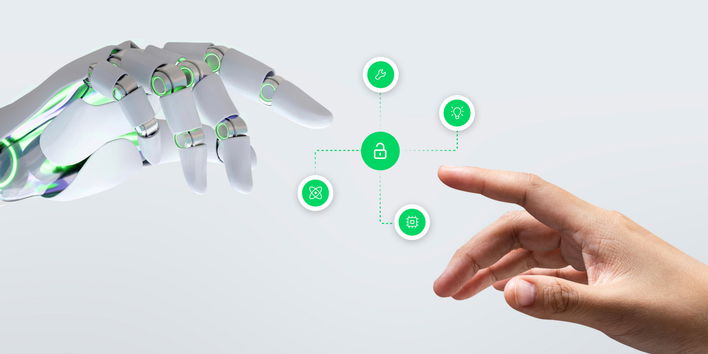"Artificial intelligence (AI) is expected to contribute USD 15.7 trillion to the global economy by 2030."
– Dataprot
With the growth of artificial intelligence (AI) and machine learning (ML), we will witness more automation and an intelligent way of living in the upcoming years.
AI is a great example of how rapidly we are moving towards a more robust future.
With the new technology of AI, there are plenty of AI tools that help the technology work more efficiently.
These AI tools, data visualization tools, tips, and everything around this futuristic tech stack enables data scientists to predict a better and more meticulous future.
Let's dive right into the most prominent and widely used AI tools that are building our beautiful future:
PyTorch
Pytorch is an AI system developed by Meta. The base programming language used to develop Pytorch is Python.
The framework is mainly built to speed up the process between research prototyping and deployment.
It is an open-source machine learning framework based on the Torch library. Github has made its code accessible among all the developers, and it's pretty popular among the techies.
Pytorch is renowned as one of the most preferred platforms for deep learning.
- Microsoft uses PyTorch since 2018 for their language modeling service. In order to build advanced architecture, they used the native extensibility that PyTorch provides.
- Airbnb relies highly on PyTorch for smart and mindful recommendation replies in their customer service.

TensorFlow
TensorFlow is an open-source, free software library for machine learning and artificial intelligence. It can be easily deployed on the cloud, browser, or device, regardless of your programming language.
TensorFlow is popular because of its comprehensive, flexible ecosystem of tools, libraries, and community support.
It provides an API that lets you develop and deploy complex input pipelines from simple, reusable components.
This feature allows developers to focus on the logic part of the program and not the nitty-gritty of placing the correct code and components in the right place.
Like Pytorch, TensorFlow is one of the most used libraries for deep learning. It enables developers to construct neural networks and create graphical visualizations using Tensorboard.
- For powering Gmail, Google Translate, and Google Search, Google relies on TensorFlow.
- AirBus depends on TensorFlow for extracting information from their satellite images and delivering insights to their clients.

Keras
Keras is an open-source software library that enables users to utilize the Python interface for artificial neural networks.
Since it is created on Python, Keras is more user-friendly and accurate in terms of data.
Keras is an extended and better version of TensorFlow. It is a high-level API of TensorFlow. It is developed to solve machine learning problems that have high iteration velocity.
Keras run seamlessly on both CPU (Central Processing Unit) and GPU (Graphics Processing Unit).
It is more advanced than the other tools; it does faster prototyping that facilitates the completion of great experiments through the process where you see no delay or compromise in accuracy.
If your data is crucial, without a doubt, Keras is your best option.
- For faster experimentation and improving recommendation, Netflix uses Keras.
- To improve review classification and user experience, Yelp utilizes Keras and their architecture.

AutoML
As the name suggests, AutoML is the process of applying machine learning models to real-world problems using automation.
It is designed and developed by non-experts to use machine learning models and techniques to understand their data better.
AutoML works more toward optimizing and refining comprehensive data for better and more accurate predictions.
It is a library that successfully helps users determine optimal hyperparameters related to their past data to understand the future better.
It is one such library that is fully equipped with advanced logic and prediction powers, yet easy to use even for non-experts.
- To enhance the machine learning capabilities, Google Cloud uses AutoML models.
- DataRobot technically invented automated machine learning so, to enhance it consistently, they choose AutoML over other AI tools.

Theano
Theano is a Python library and an optimizing compiler that enables users to manipulate and evaluate mathematical expressions, especially those with matrix values.
It was launched in 2007 and is believed to be one of the oldest tools. Keeping Theano is base, other, more efficient tools are developed and built that are widely used now among the developers' community.
Features like tight integration with NumPy, speed and stability optimizations, extensive unit testing, etc. That still keeps this old tool relevant and useful among the new efficient ones.
If we are just talking about speed and usability, Theano wins among the five tools mentioned here.
- JPMorgan Chase uses rational database systems and to store that extensive data, they rely on Theano.
- BigBear.ai helps governments and large businesses to take future decisions so their data and research have to be precise and perfect. They choose Theano for making them an enterprise-ready solution partner.

Closing lines
Like any other comparison article, we are not putting together all the data for all five tools for you to compare and scrutinize because they all are used for different purposes.
'One size fits all’ is not the approach we believe in, especially when the needs are dynamic and technology is ever-changing.
When we are seeing the dawn of the most significant tech of all time, when 37% of futuristic businesses have started to employ people working around AI, the only way to test the waters is to embrace the new change.
As a first step, maybe start by deciding on the right AI tool for your business that works well with the data visualization tool you prefer to use within the company!

Niyati Madhvani
A flamboyant, hazel-eyed lady, Niyati loves learning new dynamics around marketing and sales. She specializes in building relationships with people through her conversational and writing skills. When she is not thinking about the next content campaign, you'll find her traveling and dwelling in books of any genre!
What’s Inside

Let’s build the next big thing!
Share your ideas and vision with us to explore your digital opportunities
Similar Stories
- Trends
- undefined Mins
- May 2021

- Trends
- undefined Mins
- April 2022

- Trends
- undefined Mins
- March 2017


Receive articles like this in your mailbox
Sign up to get weekly insights & inspiration in your inbox.
